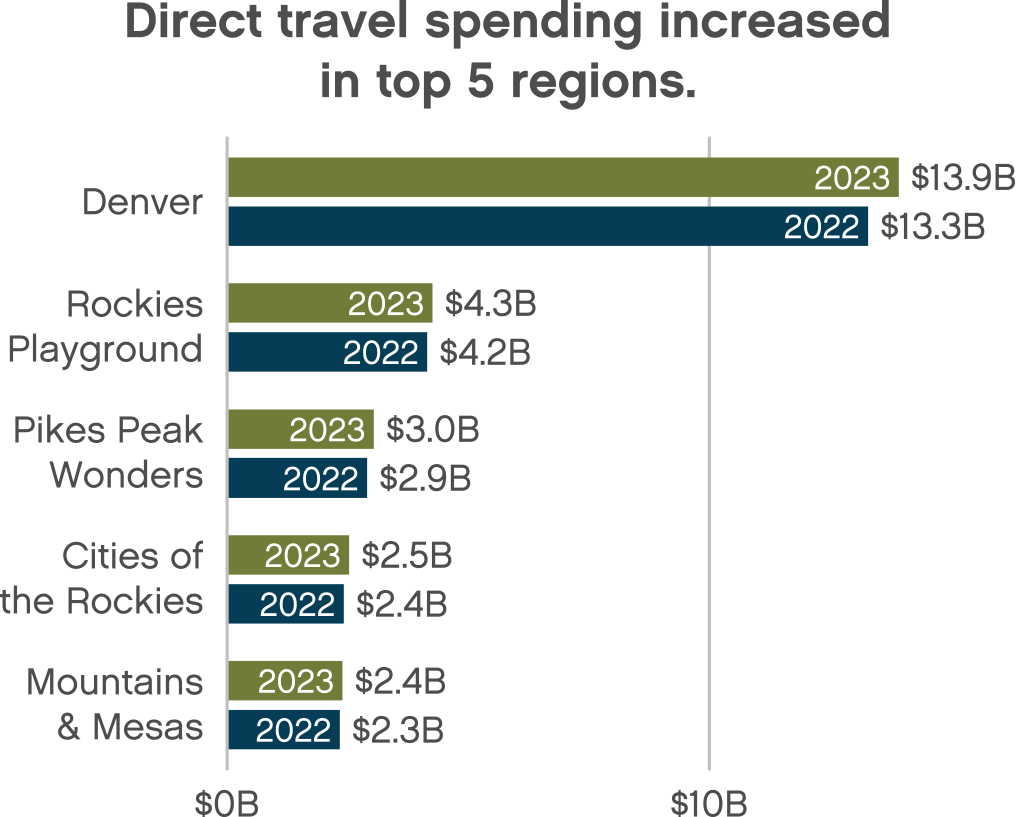Colorado’s picturesque landscapes, diverse recreational opportunities, and vibrant cultural attractions have made it an increasingly popular destination for travelers worldwide. In 2023, Colorado maintained steady tourism growth, underscoring the immense importance of this industry to Colorado’s economy, communities, and residents.
In 2023, tourism spending reached $28.2 billion—a 3.9% increase from the previous year. All five of the travel regions that generate the highest travel spending in Colorado grew in 2023. The highest growth rate was 4.8% for the Denver region, compared to a growth rate of 3.9% for the state. Travelers spent approximately $13.9 billion in the Denver region alone in 2023, making up almost half (49.4%) of the state-wide total.


Dean Runyan Associates. The Economic Impact of Travel in Colorado 2023. July 17, 2024.
Tourism generates substantial tax revenues, with $1.8 billion collected in local and state taxes during 2023, translating to $800 in tax benefits per Colorado household. These funds support essential public services, infrastructure development, and community improvement initiatives, benefiting visitors and residents alike.
In 2023, Colorado’s tourism sector continued as a robust driver of employment. The state added 9,450 new travel-related jobs compared to the previous year. Direct employment generated by travel continues to experience growth, rising from 178,260 to 187,710 jobs in 2023. From 2013-2023, Colorado travel employment grew at an average annual rate of 2.6%.
While the statistics highlight the substantial economic impact of tourism, they only hint at the broader significance of this industry. Tourism stimulates economic growth and acts as a catalyst for cultural exchange and understanding among diverse communities. Economic metrics are just the beginning of the story, and the CTO is redefining success alongside the tourism industry to make destination stewardship a critical component.
Tourism generates substantial tax revenues, with $1.8 billion collected in local and state taxes during 2023, translating to $800 in tax benefits per Colorado household. These funds support essential public services, infrastructure development, and community improvement initiatives, benefiting visitors and residents alike.
In 2023, Colorado’s tourism sector continued as a robust driver of employment and economic growth. The state added 9,450 new travel-related jobs compared to the previous year. Direct employment generated by travel continues to experience growth, rising from 178,260 to 187,710 jobs in 2023. From 2013-2023, Colorado travel employment grew at an average annual rate of 2.6%.
While the statistics highlight the significant economic impact of tourism, they only hint at the broader significance of this industry. Tourism stimulates economic growth and acts as a catalyst for cultural exchange and understanding among diverse communities. Economic metrics are just the beginning of the story, and the CTO is redefining success alongside the tourism industry to make destination stewardship a critical component.

Dean Runyan Associates. The Economic Impact of Travel in Colorado 2023. July 17, 2024.
Why Prioritize Destination Stewardship?
Many destinations are expanding their focus beyond traditional tourism economic metrics to prioritize outcomes that maximize benefits while minimizing negative impacts. These priorities include but are not limited to, environmental sustainability, social inclusion, cultural heritage preservation, tourism industry resilience, climate change mitigation, and new technology integration. This shift is most impactful when all stakeholders are motivated to act collectively as destination stewards. In Colorado, this approach is central to the and community-centered approach of the Destination Stewardship Strategic Plan.
